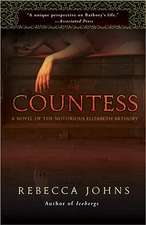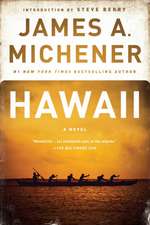The Source
Autor James A. Micheneren Limba Engleză Paperback – 14 aug 2002
Praise for The Source
"Fascinating . . . stunning . . . [a] wonderful rampage through history . . . Biblical history, as seen through the eyes of a professor who is puzzled, appalled, delighted, enriched and impoverished by the spectacle of a land where all men are archeologists."-The New York Times
"A sweeping [novel] filled with excitement-pagan ritual, the clash of armies, ancient and modern: the evolving drama of man's faith."-The Philadelphia Inquirer
"Magnificent . . . a superlative piece of writing both in scope and technique . . . one of the great books of this generation."-San Francisco Call Bulletin
Preț: 129.77 lei
Nou
Puncte Express: 195
Preț estimativ în valută:
24.83€ • 25.83$ • 20.50£
24.83€ • 25.83$ • 20.50£
Carte disponibilă
Livrare economică 24 martie-07 aprilie
Livrare express 08-14 martie pentru 37.99 lei
Preluare comenzi: 021 569.72.76
Specificații
ISBN-13: 9780375760389
ISBN-10: 0375760385
Pagini: 1104
Ilustrații: maps
Dimensiuni: 130 x 205 x 32 mm
Greutate: 0.68 kg
Ediția:New ed.
Editura: Dial Press
Locul publicării:United States
ISBN-10: 0375760385
Pagini: 1104
Ilustrații: maps
Dimensiuni: 130 x 205 x 32 mm
Greutate: 0.68 kg
Ediția:New ed.
Editura: Dial Press
Locul publicării:United States
Extras
On Tuesday the freighter steamed through the Straits of Gibraltar and for five days plowed eastward through the Mediterranean, past islands and peninsulas rich in history, so that on Saturday night the steward advised Dr. Cullinane, “If you wish an early sigh of the Holy Land you must be up at dawn.” The steward was Italian and was reluctant to use the name Israel. For him, good Catholic that he was, it would always be the Holy Land.
Some time before dawn Cullinane heard a rapping on his door and went on deck while the stars were still bright, but as the moon fell away toward areas he had left, the sun began to rise over the land he was seeking, and the crown of stars that hung over Israel glimmered fitfully and faded. The shoreline became visible, mauve hills in the gray dawn, and he saw three things he knew: to the left the white Muslim mosque of Akko, in the center the golden dome of the Bahai temple, and to the right, high on a hill, the brown battlements of the Catholic Carmelites.
“Just like the Jews,” he said. “Denied religious liberty by all, they extend it to everyone.” He thought that might be a good motto for the new state, but as the freighter approached land he added, “I’d feel more like a traveler to Israel if they’d let me see one good synagogue.” But the Jewish religion was an internal thing, a system for organizing life rather than building edifices, and no Jewish religious structures were visible.
Even at the dockside his introduction to the Jewish state was postponed, for the firs man who recognized him was a genial, good-looking Arab in his late thirties, dressed nattily in western clothes, who called from the shore in English, “Welcome! Welcome! Everything’s ready.” Two generations of British and American archaeologists had been greeted with this heartening call, either by the present Jemail Tabari or by his famous uncle, Mahmoud, who had worked on most of the historic digs in the area. Dr. Cullinane, from the Biblical Museum in Chicago, was reassured.
For many years he had dreamed of excavating one of the silent mounds in the Holy Land, perhaps even to uncover additional clues to the history of man and his gods as they interacted in this ancient land; and as he waited for the freighter to tie up he looked across the bay to Akko, that jewel of a seaport, where so much of the history he was about to probe had started. Phoenicians, Greeks, Romans, Arabs, and finally Richard the Lion Heart and his Crusaders had all come to that harbor in glorious panoply, and to follow in their footsteps was for an archaeologist like Cullinane a privilege.” I hope I do a good job,” he whispered.
Some time before dawn Cullinane heard a rapping on his door and went on deck while the stars were still bright, but as the moon fell away toward areas he had left, the sun began to rise over the land he was seeking, and the crown of stars that hung over Israel glimmered fitfully and faded. The shoreline became visible, mauve hills in the gray dawn, and he saw three things he knew: to the left the white Muslim mosque of Akko, in the center the golden dome of the Bahai temple, and to the right, high on a hill, the brown battlements of the Catholic Carmelites.
“Just like the Jews,” he said. “Denied religious liberty by all, they extend it to everyone.” He thought that might be a good motto for the new state, but as the freighter approached land he added, “I’d feel more like a traveler to Israel if they’d let me see one good synagogue.” But the Jewish religion was an internal thing, a system for organizing life rather than building edifices, and no Jewish religious structures were visible.
Even at the dockside his introduction to the Jewish state was postponed, for the firs man who recognized him was a genial, good-looking Arab in his late thirties, dressed nattily in western clothes, who called from the shore in English, “Welcome! Welcome! Everything’s ready.” Two generations of British and American archaeologists had been greeted with this heartening call, either by the present Jemail Tabari or by his famous uncle, Mahmoud, who had worked on most of the historic digs in the area. Dr. Cullinane, from the Biblical Museum in Chicago, was reassured.
For many years he had dreamed of excavating one of the silent mounds in the Holy Land, perhaps even to uncover additional clues to the history of man and his gods as they interacted in this ancient land; and as he waited for the freighter to tie up he looked across the bay to Akko, that jewel of a seaport, where so much of the history he was about to probe had started. Phoenicians, Greeks, Romans, Arabs, and finally Richard the Lion Heart and his Crusaders had all come to that harbor in glorious panoply, and to follow in their footsteps was for an archaeologist like Cullinane a privilege.” I hope I do a good job,” he whispered.
Recenzii
“Fascinating . . . a wonderful rampage through history.”—The New York Times
“James Michener is something rare and valuable: an honorable craftsman doing honorable work. . . . He manages
to make history vivid.”—The Boston Globe
“Magnificent . . . a superlative piece of writing both in scope and technique. It is, in fact, one of the great books of this generation. . . . It will hold the interest of any reader, no matter what religion he may be.”—San Francisco Call Bulletin
“James Michener is something rare and valuable: an honorable craftsman doing honorable work. . . . He manages
to make history vivid.”—The Boston Globe
“Magnificent . . . a superlative piece of writing both in scope and technique. It is, in fact, one of the great books of this generation. . . . It will hold the interest of any reader, no matter what religion he may be.”—San Francisco Call Bulletin
Notă biografică
Universally revered novelist James A. Michener was forty before he decided on writing as a career. Prior to that, he had been an outstanding academic, an editor, and a U.S. Navy lieutenant commander in the Pacific Theater during World War II. His first book, Tales of the South Pacific, won a Pulitzer Prize and became the basis of the award-winning Rodgers and Hammerstein musical South Pacific. In the course of the next forty years Mr. Michener wrote such monumental bestsellers as Sayonara, The Bridges at Toko-Ri, Hawaii, The Source, Chesapeake, Centennial, Texas, Alaska, Caribbean, and Mexico.
Decorated with America's highest civilian award, the Presidential Medal of Freedom, Mr. Michener served on the Advisory Council to NASA, held honorary doctorates in five fields from thirty leading universities, and received an award from the President's Committee on the Arts and Humanities for his continuing commitment to art in America. James A. Michener died on October 16, 1997.
Decorated with America's highest civilian award, the Presidential Medal of Freedom, Mr. Michener served on the Advisory Council to NASA, held honorary doctorates in five fields from thirty leading universities, and received an award from the President's Committee on the Arts and Humanities for his continuing commitment to art in America. James A. Michener died on October 16, 1997.
Descriere
Now for the first time in trade paperback, Michener's magnificent and spellbinding expedition through the history of the Holy Land, the source of Western religious and cultural heritage.























